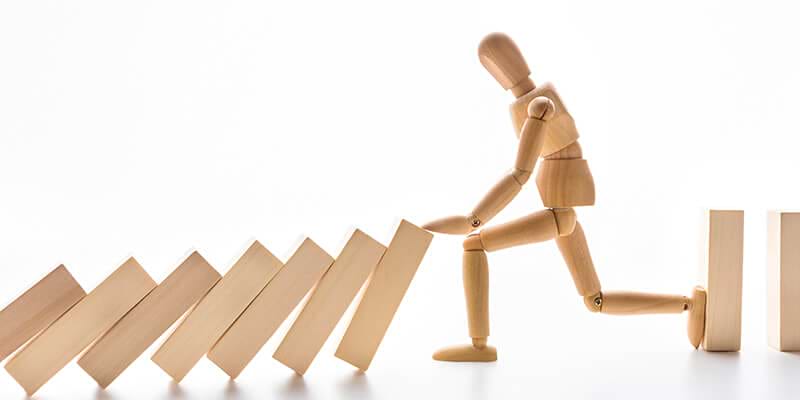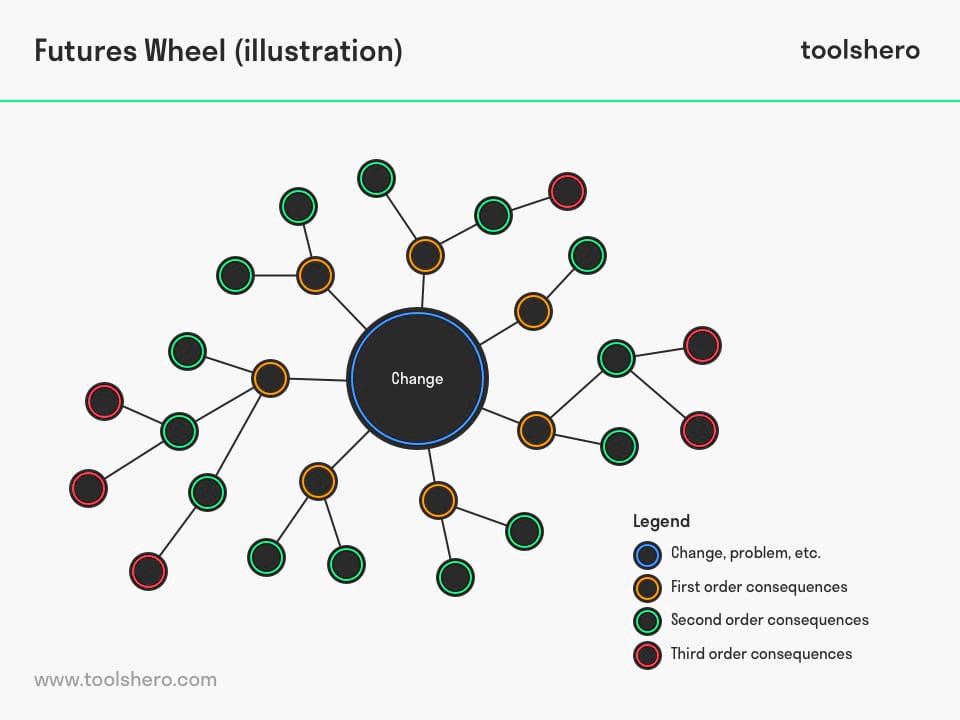Futures Wheel Analysis and Method explained: Theory and Example

Futures Wheel Analysis and Method: this article explains the Futures Wheel by Jerome Glenn in a practical way. Next to what it is, this article also highlights this Method as a brainstorming technique, the five steps of the Futures Wheel Analysis and Method (including an example), tips and the relationships between consequences. After reading it, you will understand the basics of this decision making method. Enjoy reading!
What is the Futures Wheel Analysis and Method?
The American scientist Jerome C. Glenn is mostly known for his work in futurology. He conducted research for governments and international organisations. He held speeches around the world on subjects pertaining to the future.
Origin
In the 1970s, he invented the Futures Wheel: a method for graphically developing a visualisation of direct and indirect future consequences of a certain change or development. He created the Futures Wheel in order to identify possible consequences of trends and events.
Nevertheless, it is also useful in business decision making, where it can be used to select certain options. The Futures Wheel also helps identify the consequences of change in change management.
In addition, a Futures Wheel can be used to gain an insight into how various parts of an event are connected. This prevents certain results of change from being overlooked and offers insight into the impact of certain decisions.
The Futures Wheel Analysis and Method is a brainstorming technique
The Futures Wheel is a method for thinking about future events. By organising this with multiple people at the same time, it turns into a structured brainstorming session.
You brainstorm together about the future of a specific subject; you predict what the effect of the change, adjustment, or decision could be. The power of the visual aspect ensures everyone will feel engaged and better understand the consequences of the change or development. In most cases, colours are used.
Together, they will identify the consequences of a change and make them visible, which creates an overview of what could happen as a result of the decision. People usually find it difficult to identify possible results.
With the Futures Wheel, each participant participates, and it becomes easier for them to make a contribution. It allows people to think in a structured manner about the direct and indirect consequences of a decision, event, or trend.
Five Steps to work with Futures Wheel
Drawing a Futures Wheel is very simple and consists of five steps. It’s a good idea to give a short explanation and instructions to participants beforehand. It is preferable to work in pairs. Each pair has a large piece of paper or a flip chart sheet, as well as colour pens. They are told the subject. The step-by-step method provides the best result:
Step 1: identifying change
To start a Futures Wheel, the central term is placed in the centre of the sheet. This could be the change, an event, trend, problem, or a possible solution to a problem. By identifying this change, it is clear to all participants what the starting point of this brainstorming session is.
Suppose a toy manufacturer is struggling with excessive costs, leading its management to decide that spending should be cut by 20%. ‘20% spending cut’ is then placed in the centre of the Futures Wheel, and becomes the starting point for the possible consequences the participants will write down. In this example, ‘20% spending cut’ is written down in blue, in a circle.
Step 2: Direct consequences
Then, participants write down the ‘first-order’ consequences, which result directly from the development. These direct consequences are placed around the change, preferably in a different colour. All possible direct consequences can be considered. Each consequence is placed on a circle and connected to the central change by an arrow. These direct consequences could result from the change or decision.
Futures Wheel analysis example
In the example of the toy factory, these direct consequences are indicated by yellow circles. Think of, for example, ‘no way to invest in new means’, ‘laying off employees’, ‘reducing stocks’, ‘reducing advertising budget’.

Figure 1 – an example of the Futures Wheel
Step 3: Indirect consequences
Then, the ‘second-order’ consequences are identified. These are indirect consequences situated around the ‘first-order’ ones or the first level. These consequences are connected to the direct consequences as nodes, creating a web of consequences. This is where the brainstorming really starts: after all, indirect consequences which result from the direct consequences now have to be noted down. This can be repeated again with consequences resulting from those, creating additional, ‘third-’ and ‘fourth-order’ consequences. These are often things that happen as a result of the direct consequences. That way, a kind of trickle effect arises, which is added to the Futures Wheel itself in different colours.
For the toy manufacturer, these indirect consequences are placed in green circles. Think of, for example, ‘demotivated staff’, ‘customer complaints’, ‘logistics slowing down’ and ‘lack of consumer familiarity’.
Step 4: Analysis of implications
As soon as all levels of the Futures Wheel are completed, a clear picture arises of the possible direct and indirect consequences of the change. Listing all these implications provides an overview. The most drastic consequences can then be prioritised, with the greatest impact being at the top of the list and the least impact at the bottom.
In the example of the toy factory, the list will look like the following:
- no way of investing into new means
- customer complaints
- demotivated staff
- logistics slowing down
- laying off employees
- reducing stocks
- reducing advertising budget
- lack of consumer familiarity
Step 5: Actions
Lastly, the most negative consequences should be identified. This requires talking to one another, where both the advantages and the disadvantages should be considered. Positive consequences ought to be cherished. It is clear that, if actions have to be taken, they should fit with the aforementioned possible consequences.
The toy manufacturer will have to have a good realisation of what the benefits of a decreased investment in new means will be, and of which alternatives there are for an optimal continuation of business operations.
Apart from customers who might complain about the quality, safety, and distribution of toys, the company would do well to be alert to possible reduced motivation among staff. This, too, requires actions. Staff should be explained why the 20% cut will take place. By looking for solutions together (bottom up), staff will feel committed and be more loyal when it comes to changing along.
Tips for working with the Futures Wheel
The following tips help execute the entire Futures Wheel brainstorming process as smoothly as possible.
- As mentioned above in the step-by-step plan, it’s good to colour-code each level. This makes it clear to all participants at a glance whether they are looking at ‘first-’, ‘second-’, or higher-order consequences. This makes prioritising implications easier.
- It should also be realised that consequences definitely need not always be negative.
- It is essential that all participants understand the entire concept of the Futures Wheel before participating in the process. By having them work in pairs, they will quickly come up with useful ideas.
- After each group has made a Futures Wheel, it’s a good thing to get them to talk to one another and encourage them to listen to what the other pairs came up with.
- It’s important to set aside no more than fifteen minutes for each round. The first ideas that come up are usually the most useful.
Relationships between consequences
The Futures Wheel is usually used to order thoughts about a future development or trend. It provides a ‘what if’ experience that revolves around the consequences of an action, as well as the relationships between these consequences. This allows for structured collection of all the possible effects. The use of the interconnected lines makes the relationships between the causes and the resulting changes clear.
It’s Your Turn
What do you think? Are you familiar with the Futures Wheel? Does the visualization of consequences help you in your work and in making decisions? What tips or experiences would you like to share?
Share your experience and knowledge in the comments box below.
More information
- Bengston, D. N. (2016). The Futures Wheel: a method for exploring the implications of social–ecological change. Society & natural resources, 29(3), 374-379.
- Bishop, P., Hines, A., & Collins, T. (2007). The current state of scenario development: an overview of techniques. foresight, 9(1), 5-25.
- Glenn, J. C., & Gordon, T. J. (Eds.). (2009). Futures Research Methodology-Version 3-0. Editorial desconocida.
How to cite this article:
Mulder, P. (2019). Futures Wheel Analysis and Method explained: Theory and Example. Retrieved [insert date] from Toolshero: https://www.toolshero.com/decision-making/futures-wheel-jerome-glenn/
Published on: 08/16//2019 | Last update: 02/16/2023
Add a link to this page on your website:
<a href=”https://www.toolshero.com/decision-making/futures-wheel-jerome-glenn/”>Toolshero: Futures Wheel Analysis and Method explained: Theory and Example</a>












